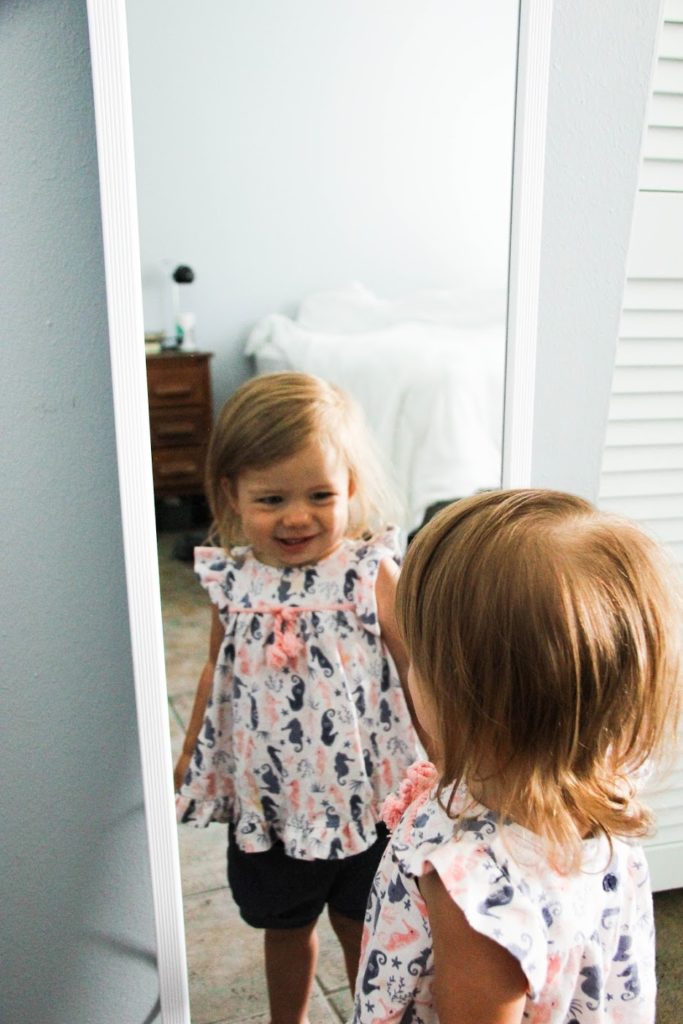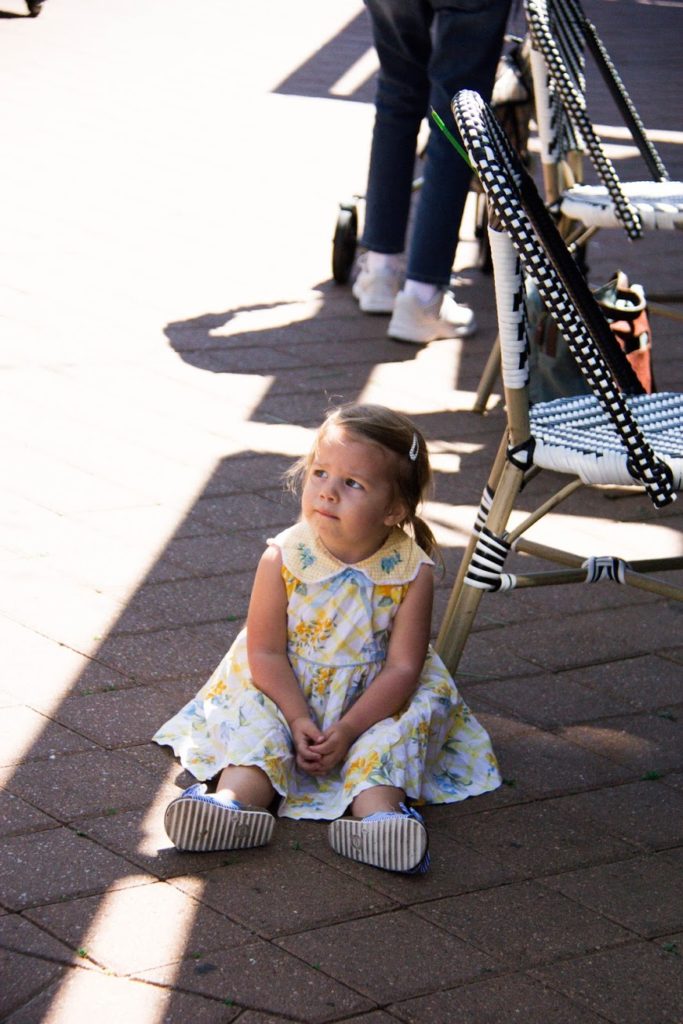If you’re in the world of two’s and three’s, then dealing with tiny emotions is part of your daily life. And by tiny I by no mean refer to the size of the emotions. Our tiny people have big emotions. They feel everything. As Genny approaches 3, I’ve seen a huge change in her emotions just in the past few months! It’s sometimes difficult to know how to properly respond to these “big emotions”, especially when they’re occurring in the middle of the grocery store. That’s why I’ve partnered with Jeremy Angus, a behavioral consultant here in the Houston area, to share 5 ways to help your children control their emotions!

What is “affective development”?
Wait…what is Affective Development? Well I’m glad you asked! It basically means emotions and how we deal with them, which can be one of the hardest things to deal with in parenting. The Limbic System (Emotional Center of the brain) develops between the ages of 0 and 5 and controls emotional processing, memory, responses to stress, nurturing, caring, separation anxiety, fear, rage, social bonding, and hormone control. This means that children under the age of 6 are purely emotional thinkers, and until about 10 years old, they still operate from this part of the brain the most.
In most cases, our adult brains have learned to suppress or ignore most emotions. In contrast, our little ones seem to be drenched in the stuff. It’s hard for us to remember how devastating a lost toy or dropped ice cream cone can be because we have experienced more “adult” stressors such as a loss of a job or loved one.
It is important to remember that stress and emotions are relative to the person experiencing them. In other words, to a child who looses a favorite toy, that IS the worse things they have experienced yet. We as parents are then charged with the task of helping them through their trauma no matter how trivial it may seem to us.
Coddling vs. coping
Now I’m not suggesting coddling a child every time they drop a sucker at the park or have a favorite balloon pop. What we need to do as parents is teach them how to cope with the emotions, while doing our best to guide them to finding their own way out of the pain. With this in mind, here are 5 ways to help your child control his emotions.
 5 Ways to Help Your Child Control His Emotions
5 Ways to Help Your Child Control His Emotions
1. Try your best to not confuse an emotional reaction for weakness.
Did you know In the United States, almost half of adults (46.4%) will experience a mental illness during their lifetime? Many researchers see this trend as stemming from our cultural trend of suppressing emotions to avoid being seen weak or “crazy.” Our children tend to pick this up either by watching their parents avoid their own emotions or by hearing common phrases such as; “Only babies cry” or “Man-up.” While most parents are simply trying to help their child calm down, we must be careful not to make them associate emotion with wrongness, or this trend could follow them into adulthood.
2. Take the time to talk about emotions with your child and listen to their experiences – you may learn something about yourself!
Did you ever have a sit-down conversation with you parents about emotions? Most likely no. This is because emotions have historically been a taboo for most people. Usually they are not addressed until someone is already emotional (which is the worst time to discuss things).
You don’t need to be an expert! You can pop in Pixar’s Inside Out and pause it every 30 minutes or so to ask your kids what their “Joy”, “Sadness”, “Fear”, and “Anger” are like. No harm can come fm exploring your own emotions with your child, it could help you both grow individually and strengthen your bond.
3. Remind them of the difference between their Feelings and their Behaviors.
It’s easy to mix these two up. For instance, when you hear the word Sad, you may think of crying and when you hear Anger you may think of yelling. These responses occur even though each of these emotions can be experienced without the associated behavior.
So, if your child throws a toy, try not to ask him, “Are you mad?” because this could strengthen the correlation between the two (being mad = throwing toys). Instead say, “Looks like your having a strong emotion. What is it, and why did it make you want to throw your toy?” This will remind them that feelings and actions don’t have to be connected.
 4. Validate what your child is feeling and let them know that emotions are normal.
4. Validate what your child is feeling and let them know that emotions are normal.
Your child may be sad from a hard day of school and simply say “Can you play with me?” because they lack the emotional vocabulary needed to tell you what’s really going on. If your child comes to you emotional, remember that it is not your job to STOP the emotion, but to guide them through it.
Think about how you feel when someone asks you to “stop being emotional.” I have yet to meet an adult who responds well to this command. Emotions are an important part of who we are and are essential to a full life experience. Our children need to understand this so they can get the most out of their lives.
5. Teach them emotional regulation skills.
American’s spend thousands of dollars a year trying to learn tips and strategies to control or remove their emotions as if they are just in the way. We don’t need to remove emotions but rather to regulate them so they can serve their purpose of guiding our decisions and amplifying our experiences.
-
- Yoga or other regular stretching activities: Remember that children are growing at a rapid rate day by day. This can often lead to muscle tension, soreness, balance issues, and fatigue. Our kids don’t know how to tell us they are sore because they don’t quite understand the sensation yet. This is why regular stretching is so important. A 10 minutes stretch in the morning could prove to be a massive stress release that the child didn’t even know she needed.

- Deep breathing and mediation (Mindfulness): The word “meditation” can turn many parents off as it is usually associated with spiritual practices. In fact, meditation is quickly becoming more recognized as an essential part of mental health practices. The idea of clearing your mind from daily stresses and focusing all your conscious attention on your breathing can reduce stress, blood pressure, muscle tension, chronic pain, and mental illness.
Being mindful simply means living in the moment rather than drifting between the regrettable past (depression) and the uncertain future (anxiety). Children can experience these as well, but they don’t know what they are or how to deal with them. For instance, depression will often look like withdrawal while anxiety looks like hyperactivity. Ten minutes of breathing in the morning and when they get home from school can pull them away from these intrusive thoughts.
-
- Role play activities: It takes an average of 15-20 repetitions to learn something, but in play it only takes between 3-5 times. A great way to teach your kids about emotions is to play out different situations before they occur. Having dad throw a tantrum on the ground and asking 3-year-old Lucy to try to calm him can be a night of fun with the family and also let her see that emotions are normal and happen to everyone. Pretending that a favorite toy is Sad and asking your child to sit with it until it feels better will make the child more receptive to you when you do this in a real situation.
Play is one of the most volatile tools in a parent’s toolbox and can create memories in the brain that can be recalled during actual emotional outbursts and difficult situations. Even having your child teach breathing and stretching techniques to the family pet can be both adorable and essential to their emotional development.
-
- Create a “pass through” activity or phrase: If you have been able to talk with your children about their emotions, you may start developing a better understanding of when the emotions are bubbling up. Children, like adults, will develop “tells” that let you know an emotion is coming (i.e., red face, crossed arms, higher pitched voice, etc.). When you see this, be sure to not try to STOP it from coming. Rather, create a pass-through activity or phrase to help they get through the emotion so it is not put on the shelf to come back stronger later.
For instance, if you see your child getting upset because it’s raining on the day he wanted to go to the park, ask him, “How does not being able to go make you feel?” If they say, “It makes me sad” then reply, “I see why that would make you sad, but I can sit with you while you are sad.” This allows the child to experience the motion judgment free without the pressure of having to “buck-up” and turn off the reaction. This also gives the child a strong understanding of what the current emotion feels like so they can better recognize it in the future.
 Counting backwards or counting small objects (marbles, Legos, goldfishes.) can often times be a nice distraction from the current situation to help a child calm themselves. Remember, while distraction is a quick an easy to return a child to a calm state, this should be utilized more in public than at home to make sure they do not develop the habit of distracting themselves form their emotions, which can cause issues in adult life.
Counting backwards or counting small objects (marbles, Legos, goldfishes.) can often times be a nice distraction from the current situation to help a child calm themselves. Remember, while distraction is a quick an easy to return a child to a calm state, this should be utilized more in public than at home to make sure they do not develop the habit of distracting themselves form their emotions, which can cause issues in adult life.
If your child has trouble communicating verbally…
If your child is not talking yet or struggles with conversation, you can do this without words. Simply approach the child, establish eye contact, match their facial expressing, and then embrace them as they make their way through the emotion. Think about what you would want from another person while you are going through an emotion. Most of the time just having someone there to support you while you experience it can be the greatest relief, and our children deserve the same approach.
If the emotions have grown too far out of control…
In some cases, your child’s emotions escalate to the point that you may have to remove her from the area, but try your best to stop talking. It is important for parents to realize that the brain needs resources in order to calm itself. Trying to understand what is being said to you when you’re mad takes these resources away and will delay the child’s ability to calm down. Facial expressions, gestures, and visual aids are processed easier by the brain and are better alternatives to lengthy overcorrection.
It doesn’t have to be scary
Affective Development (Emotions) doesn’t have to be scary or difficult to deal with. These are just natural occurrences that help us guide our decisions and add flavor to life. When parents realize that while their brains operate logically, their 5 year old’s brain operates purely emotionally, there is usually a shift in approach. We can get frustrated with our kids because they don’t think logically, but unfortunately that part of their brain wont be developed until mid to late 20s! Until then we need to be patient, kind, understanding, and loving. We need to remember that emotions are important to our kids’ development and that if we suppress them, the trend of mental illness in our country will continue to grow.
Bottling up emotions is not a good idea, neither is letting them control our lives. The best way to avoid this for your child is to normalize emotions and have them be part of the learning experience. Cry with your child when something makes you sad ,and laugh with them when you are happy. Play with them as a tool for learning, and validate the way they feel. If you can do this, you will conquer the world of Affective Development.
Jeremy Angus

Being diagnosed as legally blind at a young age, Jeremy chose a life of helping families with children also struggling with a variety of disabilities. With an undergraduate degree in Psychology and masters degree in School Psychology, Jeremy worked as a Licensed Specialist in School Psychology (LSSP) for 6 years. Now he works independently with a variety of non-profit organizations and as a consultant to local families focusing on brain development and behavior management from birth to adulthood. His philosophy is that, by teaching parents how their brains and their children’s brains work, many frustrations can be avoided and the parent/child bond can be strengthened.
What is the hardest part about dealing with your child’s emotions? Share with me by commenting below!
Love, Emily XOXO







What People Are Saying